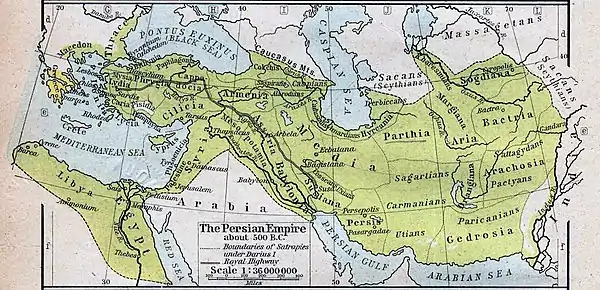Late Period of ancient Egypt
The Late Period of ancient Egypt refers to the last flowering of native Egyptian rulers after the Third Intermediate Period in the 26th Saite Dynasty founded by Psamtik I, but includes the time of Achaemenid Persian rule over Egypt after the conquest by Cambyses II in 525 BC as well. The Late Period existed from 664 BC until 332 BC, following a period of foreign rule by the Nubian 25th dynasty and beginning with a short period of Neo-Assyrian suzerainty, with Psamtik I initially ruling as their vassal. The period ended with the conquests of the Persian Empire by Alexander the Great and establishment of the Ptolemaic dynasty by his general Ptolemy I Soter, one of the Hellenistic diadochi from Macedon in northern Greece. With the Macedonian Greek conquest in the latter half of the 4th century BC, the age of Hellenistic Egypt began.
Late Period of ancient Egypt | |||||||||||
|---|---|---|---|---|---|---|---|---|---|---|---|
| c. 664 BC – c. 332 BC | |||||||||||
 Egypt in the 6th century BC (in purple). | |||||||||||
| Capital | Sais, Mendes, Sebennytos | ||||||||||
| Common languages | Ancient Egyptian | ||||||||||
| Religion | Ancient Egyptian religion | ||||||||||
| Government | Monarchy | ||||||||||
| Pharaoh | |||||||||||
| History | |||||||||||
• Established | c. 664 BC | ||||||||||
• Disestablished | c. 332 BC | ||||||||||
| |||||||||||
| Today part of | |||||||||||
Part of a series on the |
||||||||||||||||||
|---|---|---|---|---|---|---|---|---|---|---|---|---|---|---|---|---|---|---|
| History of Egypt | ||||||||||||||||||
 | ||||||||||||||||||
|
||||||||||||||||||
|
||||||||||||||||||
|
||||||||||||||||||
|
||||||||||||||||||
|
||||||||||||||||||
|
||||||||||||||||||
|
| ||||||||||||||||||
| Periods and Dynasties of Ancient Egypt |
|---|
|
All years are BC |
|
See also: List of Pharaohs by Period and Dynasty Periodization of Ancient Egypt |
Libyans and Persians alternated rule with native Egyptians, but traditional conventions continued in the arts.[1]
History
26th Dynasty
The Twenty-Sixth Dynasty, also known as the Saite Dynasty after its seat of power the city of Sais, reigned from 672 to 525 BC, and consisted of six pharaohs. It started with the unification of Egypt under Psamtik I c. 656 BC, itself a direct consequence of the Sack of Thebes by the Assyrians in 663 BC. Canal construction from the Nile to the Red Sea began.
One major contribution from the Late Period of ancient Egypt was the Brooklyn Papyrus. This was a medical papyrus with a collection of medical and magical remedies for victims of snakebites based on snake type or symptoms.[2]
Artwork during this time was representative of animal cults and animal mummies. This image shows the god Pataikos wearing a scarab beetle on his head, supporting two human-headed birds on his shoulders, holding a snake in each hand, and standing atop crocodiles.[1]
27th Dynasty
The First Achaemenid Period (525–404 BC) began with the Battle of Pelusium, which saw Egypt (Old Persian: 𐎸𐎭𐎼𐎠𐎹 Mudrāya) conquered by the expansive Achaemenid Empire under Cambyses, and Egypt become a satrapy. The Twenty-seventh Dynasty of Egypt consists of the Persian emperors - including Cambyses, Xerxes I, and Darius the Great - who ruled Egypt as Pharaohs and governed through their satraps, as well as the Egyptian Petubastis III (522–520 BC) (and possibly the disputed Psammetichus IV), who rebelled in defiance of the Persian authorities. The unsuccessful revolt of Inaros II (460-454), aided by the Athenians as part of the Wars of the Delian League, aspired to the same object. The Persian satraps were Aryandes (525–522 BC; 518–c.496 BC) - whose rule was interrupted by the rebel Pharaoah Petubastis III, Pherendates (c.496–c.486 BC), Achaemenes (c.486–459 BC) - a brother of the emperor Xerxes I, and Arsames (c.454–c.406 BC).
28th–30th Dynasties
The Twenty-Eighth Dynasty consisted of a single king, Amyrtaeus, prince of Sais, who rebelled against the Persians. He left no monuments with his name. This dynasty reigned for six years, from 404 BC–398 BC.
The Twenty-Ninth Dynasty ruled from Mendes, for the period from 398 to 380 BC.
The Thirtieth Dynasty took their art style from the Twenty-Sixth Dynasty. A series of three pharaohs ruled from 380 BC until their final defeat in 343 BC led to the re-occupation by the Persians. The final ruler of this dynasty, and the final native ruler of Egypt until nearly 2,300 years later, was Nectanebo II.
31st Dynasty
The Second Achaemenid Period saw the re-inclusion of Egypt as a satrapy of the Persian Empire under the rule of the Thirty-First Dynasty, (343–332 BC) which consisted of three Persian emperors who ruled as Pharaoh - Artaxerxes III (343–338 BC), Artaxerxes IV (338–336 BC), and Darius III (336–332 BC) - interrupted by the revolt of the non-Achaemenid Khababash (338–335 BC). Persian rule in Egypt ended with the defeat of the Achaemenid Empire by Alexander the Great, who accepted the surrender of the Persian satrap of Egypt Mazaces in 332BC, and marking the beginning of Hellenistic rule in Egypt, which stabilized after Alexander's death into the Ptolemaic Kingdom.
References
- Bleiberg, Barbash & Bruno 2013, p. 16.
- Bleiberg, Barbash & Bruno 2013, p. 55.
Bibliography
- Bleiberg, Edward; Barbash, Yekaterina; Bruno, Lisa (2013). Soulful Creatures: Animal Mummies in Ancient Egypt. Brooklyn Museum. p. 151. ISBN 9781907804274.CS1 maint: ref=harv (link)
- Roberto B. Gozzoli: The Writing of History in Ancient Egypt During the First Millennium BCE (ca. 1070–180 BCE). Trend and Perspectives, London 2006, ISBN 0-9550256-3-X
- Lloyd, Alan B. 2000. "The Oxford History of Ancient Egypt, edited by Ian Shaw". Oxford and New York: Oxford University Press. 369–394
- Quirke, Stephen. 1996 "Who were the Pharaohs?", New York: Dover Publications. 71–74
- Primary sources
- Herodotus (Histories)
- Fragments of Ctesias (Persica)
- Thucydides (History of the Peloponnesian War)
- Diodorus Siculus (Bibliotheca historica)
- Fragments of Manetho (Aegyptiaca)
